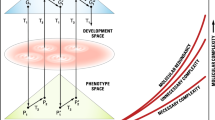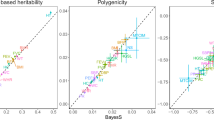Abstract
Recent years have seen an explosion of interest in genes that function for their own good and to the detriment of other genes that reside in the same genome. Such intragenomic conflicts are increasingly recognized to underpin maladaptation and disease. However, progress has been impeded by a lack of clear understanding regarding what intragenomic conflict actually means, and an associated obscurity concerning its fundamental drivers. Here we develop a general theory of intragenomic conflict in which genes are viewed as inclusive-fitness-maximizing agents that come into conflict when their inclusive-fitness interests disagree. This yields a classification of all intragenomic conflicts into three categories according to whether genes disagree about where they have come from, where they are going, or where they currently are. We illustrate each of these three basic categories, survey and classify all known forms of intragenomic conflict, and discuss the implications for organismal maladaptation and human disease.
This is a preview of subscription content, access via your institution
Access options
Access Nature and 54 other Nature Portfolio journals
Get Nature+, our best-value online-access subscription
$29.99 / 30 days
cancel any time
Subscribe to this journal
Receive 12 digital issues and online access to articles
$119.00 per year
only $9.92 per issue
Buy this article
- Purchase on Springer Link
- Instant access to full article PDF
Prices may be subject to local taxes which are calculated during checkout

Similar content being viewed by others
References
Darwin, C. R. The Origin of Species (John Murray, London, 1859).
Fisher, R. A. The Genetical Theory of Natural Selection (Clarendon, London, 1930).
Hamilton, W. D. The genetical evolution of social behaviour. J. Theor. Biol. 7, 1–52 (1964).
Price, G. R. Selection and covariance. Nature 227, 520–521 (1970).
Grafen, A. Optimisation of inclusive fitness. J. Theor. Biol. 238, 541–563 (2006).
Gardner, A. Adaptation as organism design. Biol. Lett. 6, 861–864 (2009).
West, S. A. & Gardner, A. Adaptation and inclusive fitness. Curr. Biol. 23, R577–R584 (2013).
Grafen, A. Formal Darwinism, the individual-as-maximising-agent analogy, and bet-hedging. Proc. R. Soc. Lond. B 266, 799–803 (1999).
Davies, N. B., Krebs, J. R. & West, S. A. An Introduction to Behavioural Ecology (Wiley-Blackwell, Oxford, 2012).
Haig, D. Genomic Imprinting and Kinship (Rutgers, Cambridge, 2002).
Úbeda, F. & Haig, D. Sex-specific meiotic drive and selection at an imprinted locus. Genetics 167, 2083–2095 (2004).
Úbeda, F. & Normark, B. B. Male killers and the origins of paternal genome elimination. Theor. Pop. Biol. 70, 511–526 (2006).
Burt, A. & Trivers, R. Genes in Conflict: The Biology of Selfish Genetic Elements (Harvard Univ. Press, Cambridge, 2006).
Foster, K. R. The sociobiology of molecular systems. Nat. Rev. Genet. 12, 193–203 (2011).
Úbeda, F. & Wilkins, J. F. Imprinted genes and human disease, an evolutionary perspective. Adv. Exp. Med. Biol. 626, 101–115 (2008).
Summers, K., da Silva, J. & Farwell, M. A. Intragenomic conflict and cancer. Med. Hypotheses 59, 170–179 (2002).
Constancia, M., Kelsey, G. & Reik, W. Resourceful imprinting. Nature 432, 53–57 (2004).
Úbeda, F. & Gardner, A. A model for genomic imprinting in the social brain: juveniles. Evolution 64, 2587–2600 (2010).
Úbeda, F. & Gardner, A. A model for genomic imprinting in the social brain: adults. Evolution 65, 462–475 (2011).
Úbeda, F. & Gardner, A. A model for genomic imprinting in the social brain: elders. Evolution 66, 1567–1581 (2012).
Crespi, B., Foster, K. & Úbeda, F. First principles of Hamiltonian medicine. Phil. Trans. R. Soc. B 369, 20130366 (2014).
Haig, D. Maternal–fetal conflict, genomic imprinting and mammalian vulnerabilities to cancer. Phil. Trans. R. Soc. B 370, 20140178 (2015).
Hague, W. M., Adams, J., Reeders, S. T., Peto, T. E. & Jacobs, H. S. Familial polycystic ovaries: a genetic disease? Clin. Endocrinol. 29, 593–605 (1988).
Haig, D. & Wharton, R. Prader–Willi syndrome and the evolution of human childhood. Am. J. Hum. Biol. 15, 320–329 (2003).
Úbeda, F. Evolution of genomic imprinting with biparental care: implications for Prader–Willi and Angelman syndromes. PLoS Biol. 6, e208 (2008).
Crespi, B. & Badcock, C. Psychosis and autism as diametrical disorders of the social brain. Behav. Brain. Sci. 31, 241–320 (2008).
Belancio, V. P., Deininger, P. L. & Roy-Engel, A. M. LINE dancing in the human genome: transposable elements and disease. Genome Med. 1, 97 (2009).
Chou, J. Y. & Leu, J. Y. The red queen in mitochondria: cyto-nuclear co-evolution, hybrid breakdown and human disease. Front. Genet. 6, 187 (2015).
Gavrilets, S. Is sexual conflict an “engine of speciation”? Cold Spring Harb. Perspect. Biol. 6, a017723 (2014).
Gardner, A. & Welch, J. J. A formal theory of the selfish gene. J. Evol. Biol. 24, 1801–1813 (2011).
Rousset, F. Genetic Structure and Selection in Subdivided Populations (Princeton Univ. Press, Princeton, 2004).
Hamilton, W. D. Altruism and related phenomena, mainly in social insects. Annu. Rev. Ecol. Syst. 3, 193–232 (1972).
Hurst, L. D., Atlan, A. & Bengtsson, B. O. Genetic conflicts. Q. Rev. Biol. 71, 317–364 (1996).
Charlesworth, B. Conflicts of interest. Curr. Biol. 16, R1009–R1011 (2006).
Haig, D. Parental antagonism, relatedness asymmetries, and genomic imprinting. Proc. R. Soc. Lond. B 264, 1657–1662 (1997).
Úbeda, F. & Haig, D. Dividing the child. Genetica 117, 103–110 (2003).
Moore, T. & Haig, D. Genomic imprinting in mammalian development: a parental tug-of-war. Trends Genet. 7, 45–49 (1991).
Crow, J. F. The ultraselfish gene. Genetics 118, 389–391 (1988).
Lindholm, A. K. et al. The ecology and evolutionary dynamics of meiotic drive. Trends Ecol. Evol. 31, 315–326 (2016).
Larracuente, A. M. & Presgraves, D. C. The selfish segregation distorter gene complex of Drosophila melanogaster. Genetics 192, 33–53 (2012).
Leigh, E. G. Jr. How does selection reconcile individual advantage with the good of the group? Proc. Natl Acad. Sci. USA 74, 4542–4546 (1977).
Dawkins, R. The Selfish Gene (Oxford Univ. Press, Oxford, 1976).
Gardner, A. & West, S. A. Greenbeards. Evolution 64, 25–38 (2010).
Ridley, M. & Grafen, A. Are green beard genes outlaws? Anim. Behav. 29, 954–955 (1981).
Dawkins, R. The Extended Phenotype (Oxford Univ. PRess, Oxford, 1982).
Biernaskie, J. M., West, S. A. & Gardner, A. Are greenbeards intragenomic outlaws? Evolution 65, 2729–2742 (2011).
Alexander, R. D. & Borgia, G. Group selection, altruism, and levels of organization of life. Annu. Rev. Ecol. Evol. Syst. 9, 449–474 (1978).
Seger, J. Evolution of responses to relative homozygosity. Nature 262, 579–580 (1976).
Dall, S. R. X., McNamara, J. M. & Leimar, O. Genes as cues: phenotypic integration of genetic and epigenetic information from a Darwinian perspective. Trends Ecol. Evol. 30, 327–333 (2015).
Leimar, O., Dall, S. R. X., Hammerstein, P. & McNamara, J. M. Genes as cues of relatedness and social evolution in heterogeneous environments. PLoS Comput. Biol. 12, e1005006 (2016).
Cosmides, L. M. & Tooby, J. Cytoplasmic inheritance and intragenomic conflict. J. Theor. Biol. 89, 83–129 (1981).
Werren, J. H. Selfish genetic elements, genetic conflict, and evolutionary innovation. Proc. Natl Acad. Sci. USA 108, 10863–10870 (2011).
Rice, W. R. Nothing in genetics makes sense except in the light of genomic conflict. Annu. Rev. Ecol. Evol. Syst. 44, 217–237 (2013).
Okasha, S. Evolution and the Levels of Selection (Oxford Univ. Press, Oxford, 2006).
Pomiankowski, A. in Levels of Selection in Evolution (ed. Keller, L.) 121–152 (Princeton Univ. Press, Princeton, 1999).
Spencer, H. G. in The Encyclopedia of Life Sciences (Wiley, 2003).
Brandvain, Y. Matrisibs, patrisibs, and the evolution of imprinting on autosomes and sex chromosomes. Am. Nat. 176, 511–521 (2010).
Gardner, A. Genomic imprinting and the units of adaptation. Heredity 113, 104–111 (2014).
Williams, G. C. Adaptation and Natural Selection (Princeton Univ. Press, Princeton, 1966).
Williams, G. C. Natural Selection: Domains, Levels, and Challenges (Oxford Univ. Press, Oxford, 1992).
Stencel, A. & Crespi, B. What is a genome? Molec. Ecol. 22, 3437–3443 (2013).
Trivers, R. L. in Sexual Selection and the Descent of Man 1871–1971 (ed. Campbell, B.) 136–179 (Aldine, 1972).
Trivers, R. L. Parent–offspring conflict. Am. Zool. 14, 249–264 (1974).
Mock, D. W. & Parker, G. A. The Evolution of Sibling Rivalry (Oxford Univ. Press, Oxford, 1997).
Rice, W. R. & Holland, B. The enemies within: intergenomic conflict, interlocus contest evolution (ICE), and the intraspecific Red Queen. Behav. Ecol. Sociobiol. 41, 1–10 (1997).
Chapman, T., Arnqvist, G., Bangham, J. & Rowe, L. Sexual conflict. Trends Ecol. Evol. 18, 41–47 (2003).
Haig, D., Úbeda, F. & Patten, M. M. Specialists and generalists: the sexual ecology of the genome. Cold Spring Harb. Perspect. Biol. 6, 017525 (2014).
Godfray, H. C. J. Evolutionary theory of parent–offspring conflict. Nature 376, 133–138 (1995).
Gardner, A. & Ross, L. Mating ecology explains patterns of genome elimination. Ecol. Lett. 17, 1602–1612 (2014).
Haig, D. Placental hormones, genomic imprinting, and maternal–fetal communication. J. Evol. Biol. 9, 357–380 (1996).
Farrell, E. J., Úbeda, F. & Gardner, A. Intragenomic conflict over dispersal. Am. Nat. 186, E61–E71 (2015).
Wilkins, J. F. Genomic imprinting and conflict-induced decanalization. Evolution 65, 537–553 (2011).
Bulmer, M. G. Theoretical Evolutionary Ecology (Sinauer, Sunderland, 1994).
Gardner, A. The genetical theory of multilevel selection. J. Evol. Biol. 28, 305–319 (2015).
Úbeda, F. & Gardner, A. Mother and offspring in conflict: why not? PLoS Biol. 13, e1002084 (2015).
Acknowledgements
We thank S. Frank and M. Morrissey for helpful comments and discussion, and F. Úbeda Izargain for an original source of intragenomic conflict. A.G. is supported by an Independent Research Fellowship from the Natural Environment Research Council (NE/K009524/1).
Author information
Authors and Affiliations
Contributions
A.G. and F.Ú. conceived the study, performed the analyses and wrote the paper.
Corresponding authors
Ethics declarations
Competing interests
The authors declare no competing financial interests.
Additional information
Publisher’s note: Springer Nature remains neutral with regard to jurisdictional claims in published maps and institutional affiliations.
Electronic supplementary material
Supplementary Information
Supplementary methods.
Rights and permissions
About this article
Cite this article
Gardner, A., Úbeda, F. The meaning of intragenomic conflict. Nat Ecol Evol 1, 1807–1815 (2017). https://doi.org/10.1038/s41559-017-0354-9
Received:
Accepted:
Published:
Issue Date:
DOI: https://doi.org/10.1038/s41559-017-0354-9
This article is cited by
-
Examining parent-of-origin effects on transcription and RNA methylation in mediating aggressive behavior in honey bees (Apis mellifera)
BMC Genomics (2023)
-
Indel driven rapid evolution of core nuclear pore protein gene promoters
Scientific Reports (2023)
-
Non-Mendelian transmission of accessory chromosomes in fungi
Chromosome Research (2022)
-
Adaptation is maintained by the parliament of genes
Nature Communications (2019)
-
The agent concept is a scientific tool
Metascience (2019)



